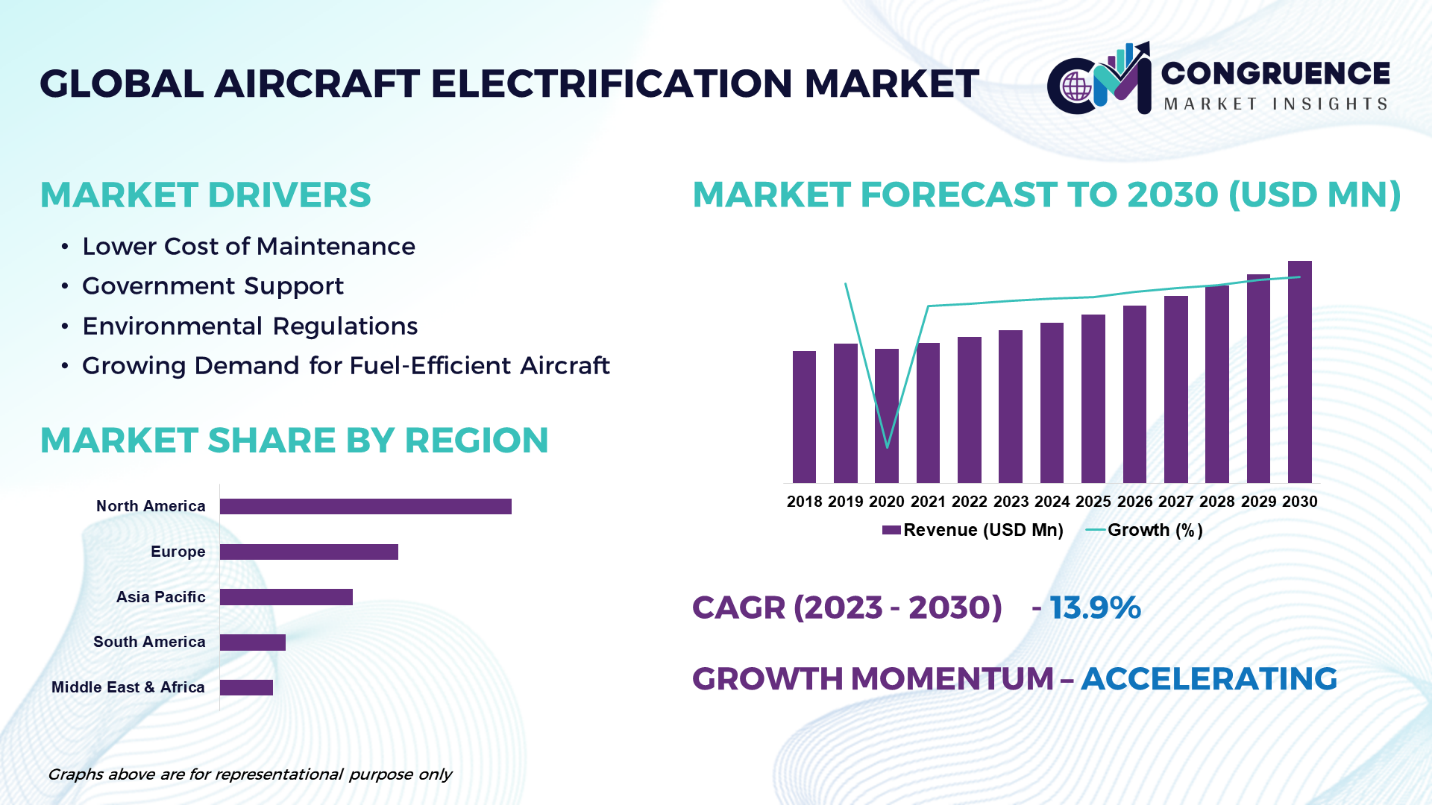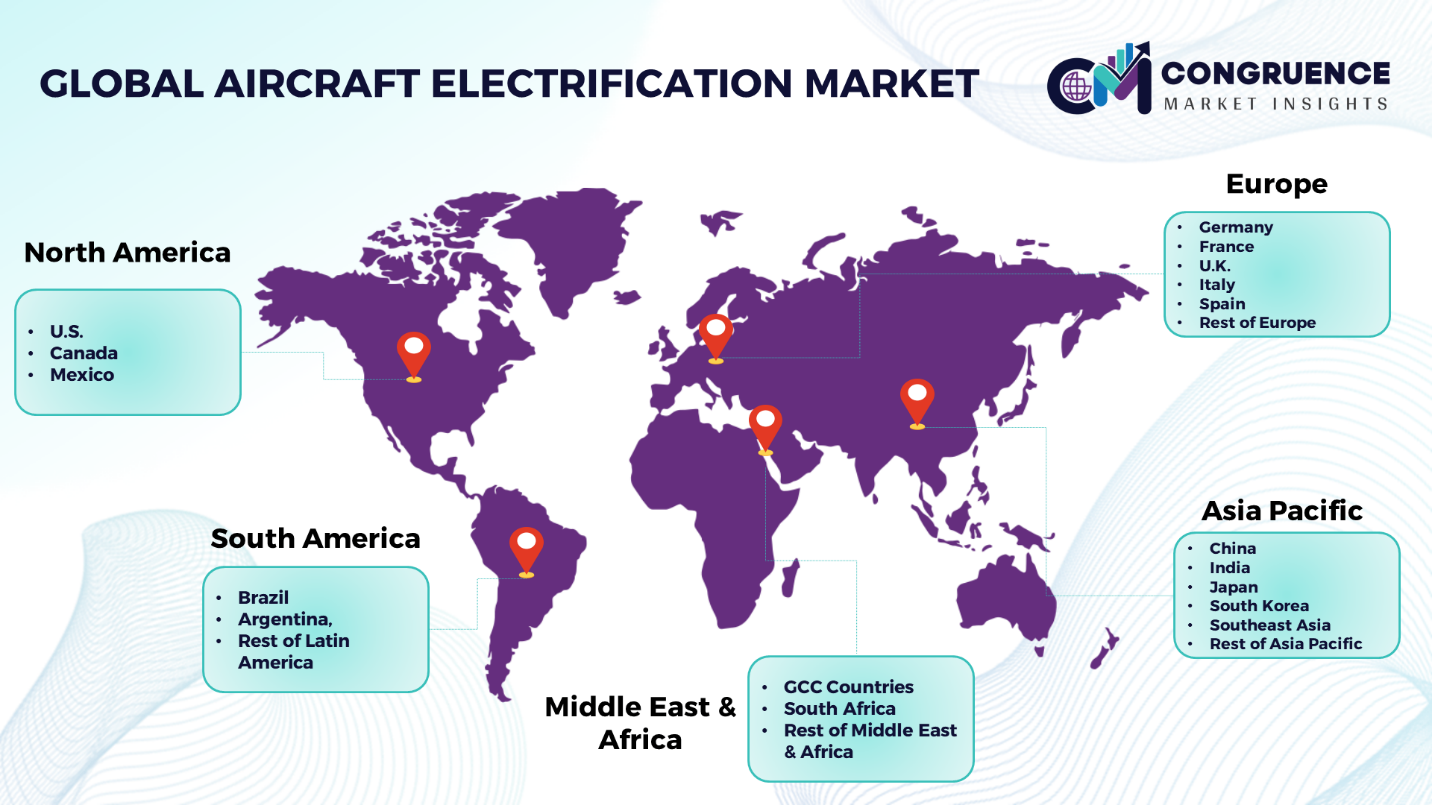Reports
The Global Aircraft Electrification Market is expected to expand at a CAGR of 13.9% between 2023 and 2030. Aircraft electrification is a process of replacement of aircraft systems with electric propulsion systems. It is the method of using electric motors to power the propeller engines of aircrafts to reduce air pollution. It is a process which incorporates electrical systems and components into aircraft to replace traditional mechanical, hydraulic, or pneumatic systems. Electric aircraft play a vital role in reducing the environmental effects of aviation by providing zero emissions flights. It involves the use of electric power or several aircraft functions, including propulsion, control systems, and auxiliary systems. An electric aircraft is powered by electric motors, the electric motors can be powered by batteries providing energy from sources such as solar, hydrogen fuel cells, photovoltaic cells, and diesel generator. The aircraft electrification process offers a number of potential benefits including reduced emissions, increased fuel efficiency, lower operating costs, and increased aircraft range. The aircraft electrification market is driven by factors such as lower cost of maintenance, government support, environmental regulations, and growing demand for fuel-efficient aircraft.

Aircraft Electrification Market Major Driving Forces
Lower Cost of Maintenance: The installation of conventional systems inside an airplane is a complex procedure, and maintaining such systems is time consuming also labor intensive. Electrification of aircraft significantly lowers the maintenance expenses as it uses fewer moving parts compared to conventional systems.
Government Support: Many governments across the globe are supporting for the development and adoption of electric aircrafts through various initiatives. Governments are providing funding for the development of electric aircraft to mitigate the environmental impact of aviation.
Environmental Regulations: Increasing environmental concerns and stringent regulations drives the demand for aircraft electrification technologies. Governments worldwide are implementing stringent regulations aimed at reducing greenhouse gas emissions are driving the adoption of aircraft electrification.
Growing Demand for Fuel-Efficient Aircraft: The increasing demand for more fuel-efficient aircraft plays a significant role in driving the growth of the global aircraft electrification market. Increasing fuel costs have led airlines to reduce their operating costs as fuel put a major expense for airlines. Electric aircraft offer the potential for significantly fuel efficiency and operational cost reductions.
Aircraft Electrification Market Key Opportunities
Technological Advancements: Technological advancements in battery technology such as development of lithium-ion batteries have made electric aviation more practical and reliable. Advancement led to improved energy density, reduced weight, and increased safety are making electric aircraft a more viable option. Innovations such as more efficient electric motors, higher energy density batteries, and advanced energy storage systems are expected to provide significant opportunities for market growth.
High-Voltage Battery Technology: Major aircraft electrification companies are focusing on high-voltage batteries which is anticipated to create profitable opportunities for market growth. A high-power density battery can enable a faster rate of energy transfer into the cells during charging. High-voltage batteries deliver greater power output, required for powering powerful electric motors of aircraft. High-voltage systems can store more energy in a smaller and lighter package compared to low-voltage batteries.
Integration of Electric Aircraft Systems: Opportunities lie in the integration of electric aircraft systems including electric propulsion, energy storage, power distribution, and flight control systems. This integration can provide tailored solutions for electric aircraft platforms, ensuring seamless communication, and reliability of onboard systems while optimizing performance and safety.
Aircraft Electrification Market Key Trends
· The major trend towards the rapid development and adoption of electric propulsion systems in aviation
· Increasing demand for cleaner and quieter aircraft is a major factor shaping the growth of the aircraft electrification market
· Integration of electric aircraft systems such as electric propulsion, energy storage, and power distribution to optimize performance
· Development of lithium-ion batteries to increase energy density, reduced weight, and increased safety
· Growing emphasis on developing sustainable aviation infrastructure to support the adoption of electric aircrafts
· Aircraft electrification is becoming popular as an option for short-distance flights, saving fuel and mechanical system operation costs for airlines
· Aircrafts are being deployed to aid humanitarian needs with their small sizes and low operational costs are becoming a popular choice

Market Competition Landscape
The global aircraft electrification market is characterized by high degree of competition among a large number of manufacturers. Key players in the aircraft electrification market have adopted various strategies aimed at gaining a competitive edge. These strategies include new product launches, product approvals, design differentiation, and partnerships and collaborations to meet evolving market demand. Established brands leverage their reputation for quality and reliability to maintain market share, while newer entrants focus on disruptive innovations and unique selling propositions.
Key players in the global aircraft electrification market implement various organic and inorganic strategies to strengthen and improve their market positioning. Prominent players in the market include:
· Airbus SE
· Honeywell International, Inc.
· BAE Systems plc
· Safran S.A.
· Thales Group
· AMETEK, Inc.
· Yuneec
· Joby Aviation.
· Astronics Corporation
· RTX
· GENERAL ELECTRIC
· Eaton
· Collins Aerospace
· Textron Inc.
· The Boeing Company
|
Report Attribute/Metric |
Details |
|
Base Year |
2022 |
|
Forecast Period |
2023 – 2030 |
|
Historical Data |
2018 to 2022 |
|
Forecast Unit |
Value (US$ Mn) |
|
Key Report Deliverable |
Revenue Forecast, Growth Trends, Market Dynamics, Segmental Overview, Regional and Country-wise Analysis, Competition Landscape |
|
Segments Covered |
· By Component (Electric Motors, Batteries, Sensors, Fuel Cells, Generators, Distribution Devices, and Others) · By Platform (Fixed Wing, Rotary Wing, Unmanned Aerial Vehicles(UAVs), and Advanced Air Mobility) · By Technology (More Electric, Hybrid Electric, and Fully Electric) · By Application (Power Generation, Power Distribution, Power Conversion, Thermal Management, and Energy Storage) |
|
Geographies Covered |
North America: U.S., Canada and Mexico Europe: Germany, France, U.K., Italy, Spain, and Rest of Europe Asia Pacific: China, India, Japan, South Korea, Southeast Asia, and Rest of Asia Pacific South America: Brazil, Argentina, and Rest of Latin America Middle East & Africa: GCC Countries, South Africa, and Rest of Middle East & Africa |
|
Key Players Analyzed |
Airbus SE, Honeywell International, Inc.,BAE Systems plc,Safran S.A.,Thales Group,AMETEK, Inc.,Yuneec,Joby Aviation.,Astronics Corporation,RTX,GENERAL ELECTRIC,Eaton,Collins Aerospace,Textron Inc., and The Boeing Company |
|
Customization & Pricing |
Available on Request (10% Customization is Free) |
